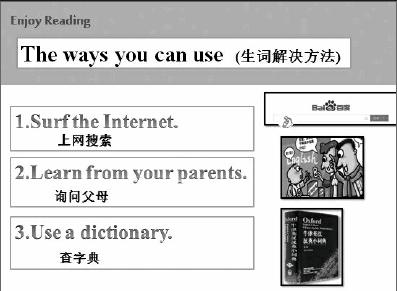小学英语读前指导的误区和对策
2017-08-26吕玮
吕玮


小学读前指导课,就是学生在教师的指导下逐步形成阅读能力和习惯的课程。教师应立足学生的阅读需要,结合整本书的内容特点,激发学生主动阅读的积极性,渗透有效的阅读方法和技巧,从而促进学生素养的提升。笔者尝试通过分析思考,探索小学阅读指导课的误区、改进和阅读指导策略。
误区一:浏览封面,人物细节全部渗透,导致学生缺乏阅读的主动性。
【案例1】
Look at the cover. What can you see?
S:I can see a cat, man, bag, and some stars.
The book is about________.
1.Whats the writer of the book?
2.Whats the title of the book?
T:Please look and name the book! Puss in ___ .(Boots)
The story is written by__________. (Charles Perrault)
T:Whose Puss is it? This is the old miller. He has got three sons. He is ill. He is going to die. He will give his three sons three things. A mill, a donkey, and a cat.
T:Which present do you want?
【问题诊断】
读前指导课的设计应该从封面入手,介绍主人公。教师设计的一系列问题应该与主人公紧密联系,鼓励学生大胆根据书的封面内容猜测可能发生的事情等,而不是教师一味地通过个别图片一一向学生呈现,并介绍所有的细节,这样会让学生失去学习和阅读的主观能动性,不利于学生的思维发展和口语表达能力的提高。
【对策和改进】
针对这个环节,学生的主动性未能很好地调动和发挥,笔者又尝试了以下设计:
1.浏览封面——看图猜测,唤醒学生思维
Learn from the cover
T:Look at the cover. What can you see?
T:This is a name. Its the writer of the book. He is Charles Perrault.
T: We can also call the cat Puss.
T:What do you think of the cat?
T:Lets look at the cover again. Please try to name the book! Puss in _________.
S:Puss in the forest…
T:Puss in Boots.<穿靴子的貓>
2.浏览封面——提供支架,自主获取信息
T:From the cover, we know the writer:_________.
The name of the book is _________.
The book is about ________and__________.
【评价】
笔者的读前设计以学生为主体,通过让学生观察故事的封面,不仅教会了学生捕捉有效信息,而且教会学生阅读故事的步骤:一看主人公,二读作者,三预测故事情节。带着预测去阅读,目的性更强,能够帮助学生更好地理解文本,也能够使阅读过程变得更有趣味。同时,学生从封面中不但可以唤起对书中主人公的兴趣,而且可以对作者、书名、人物一目了然,从而在师生思维的碰撞中,更高效地完成填空环节,有利于学生概括、推理等逻辑思维能力的提高。
误区二:浏览目录,呈现故事情节,导致学生缺少阅读兴趣。
【案例1】
T:The oldest son has got a cat, Puss. He has got only a cat.
T:Does the master like the Puss? Why will the Puss go to the castle?
S:He will go to the castle to have dinner…
T:He will bring presents for the King.
【问题诊断】
教师采用一问一答的形式,看似顺利地从第一章节过渡到第二章节,但呈现目录的目的何在?只是为了让教师顺利地承上启下吗?教师边讲边问,成了可有可无的摆设,虽然教师在问答中设计了一些有思考性的问题,但是未能把握对整本书概况的了解。其次,学生的差异照顾未能体现,对于每个章节的处理单一,学生阅读兴趣不浓,参与度不高,导致课堂效率低下。
【对策和改进】
笔者又进行了以下改进:
1.浏览目录——整体浏览,找出关键词
Learn from the table of the contents
T:What can you see from the table of the contents?
T:They are chapters. How many chapters?
S:Four chapters!
2.浏览目录——小组合作,概括整合
T:What can you get from the table of the contents? Work in groups and fill in the blanks.
【评价】
浏览目录旨在通过活动让学生产生“眼前一亮”的感觉,从而快速激发学生的阅读兴趣,引导学生进入阅读状态。笔者在读前指导学习中,精心指导學生如何阅读一本书:看封面、浏览目录、了解章节、理解章节内容等。教师在指导学生浏览目录时,对课文有了一个整体的认识。同时,笔者在设计该环节时,充分设计概括整合性的任务,通过小组合作,培养学生的归纳综合能力,从而自然习得所学的语言。
误区三:阅读章节,方法指导不到位,导致学生活动的参与率降低。
【案例1】
Problems you meet while reading
S:单词不会读,单词不认识,不理解句子意思……
T:Lets use the dictionary and find the meaning of skylark.
T:Whats the meaning of the master?
S:A.大师B.硕士C.主人D.男教师
T:Can you choose?
S:C.
T:What presents does he give to the King? Please read and circle.
【问题诊断】
教师在阅读阶段的方法指导缺乏系统性,难以帮助学生理解该章节。在教授方法阶段,教师只是让学生运用字典和选择词义的方式简单地处理个别单词,对于故事的情节,学生并不能很好地理解。教师没能精选出合适的语篇材料进行教授,在方法的指导上,更多让学生自主查找、选择,并没有环环相扣地教授阅读的方法和策略,导致学生的参与率低,阅读方法的指导流于形式。
【对策和改进】
笔者把上述问题进行整合,又重新设计:
1. 阅读章节——教有目标,学有策略
T:What problems do you meet? This time, please circle the new words. Now, what should we do?
S:We can use the dictionary.
T:I think you can use the dictionary very well.
2. 阅读章节——指导有效,读中得法
Method1: Use the dictionary
T:I have two new words. Please work in pairs and try to use the dictionary to get the meanings. skylark and master.
T:Please look up in the dictionary.
(查字典解决生词是学生必要的学习技能,也是最直接的学习生词的手段之一。)
Method2: Choose the right meaning of the dictionary
T:There are three meanings of the word.
A.大师B.硕士C.主人D.男老师
T:Which is right? Please try to choose the right meaning.
(字典中选择正确意思能够帮助学生在理解文本的基础上解决生词的含义,对学生今后的阅读大有益处。)
Method3: Read and try to guess the meaning
T:From Chapter2, Puss catches the rabbit. Here, whats the meaning of catch. I need you to act it out! Who wants to be Puss and the rabbit? Lets read together.
T:Great! Whats the meaning of catch?
S:捉住,逮着。
(通过小组合作,在阅读的基础上猜测字义,并能把单词内化成表演,不但照顾了学生的差异发展,而且可以提高学生的阅读兴趣。)
Method4: Skip reading
T:Well, what presents will the King get? Please read it quickly and find the answers: Skylark, rabbit, parrot.
(快读要求学生在有限的时间里快速浏览全文,只需要了解文本的主题思想,获取主要信息,同时也巩固和扩大了学生的词汇量,增强英语语感。)
【评价】
教师指导学生阅读章节,新授了五种阅读的技巧和策略。这五种方法的教授层层递进,环环相扣,从运用工具查字典、上下文猜测、略读、快读,无疑都体现了教师对于差异学生的不同对待。每个环节都采用小组合作、自主探究、内化表演等形式,有效地指导不同层次的学生学到阅读的方法和技巧。当学生学会运用教学策略时,就会发现他们能够控制自己的阅读行为,进而从自己的英语阅读能力中获得自信。
小学英语读前指导课中,需要教师鼓励学生主动学习,调动学生阅读的积极性,高效传授阅读的技巧,让学生享受阅读的乐趣。
(作者单位:江苏省扬州市育才实验学校)
